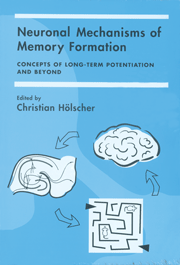Book contents
- Frontmatter
- Contents
- Contributors
- Introduction: Long-Term Potentiation as a Model for Memory Mechanisms: The Story So Far
- Section One Long-Term Potentiation In Vitro and In Vivo: How Can We Fine-Tune the Current Models for Memory Formation?
- Section Two There is More to the Picture Than Long-Term Potentiation: Theta or Gamma Oscillations in the Brain and the Facilitation of Synaptic Plasticity
- Section Three Making Models from Empirical Data of Synaptic Plasticity
- 9 Toward a Physiologic Explanation of Behavioral Data on Human Memory: The Role of Theta-Gamma Oscillations and NMDAR-Dependent LTP
- 10 Neuronal Networks, Synaptic Plasticity, and Memory Systems in Primates
- 11 Revisiting the LTP Orthodoxy: Plasticity versus Pathology
- 12 Long-Term Potentiation and Associative Learning: Can the Mechanism Subserve the Process?
- Section Four Setting the Stage for Memory Formation: Stress, Arousal, and Attention
- Section Five Transgenic Mice as Tools to Unravel the Mechanisms of Memory Formation
- Conclusions and Future Targets
- Index
9 - Toward a Physiologic Explanation of Behavioral Data on Human Memory: The Role of Theta-Gamma Oscillations and NMDAR-Dependent LTP
Published online by Cambridge University Press: 13 October 2009
- Frontmatter
- Contents
- Contributors
- Introduction: Long-Term Potentiation as a Model for Memory Mechanisms: The Story So Far
- Section One Long-Term Potentiation In Vitro and In Vivo: How Can We Fine-Tune the Current Models for Memory Formation?
- Section Two There is More to the Picture Than Long-Term Potentiation: Theta or Gamma Oscillations in the Brain and the Facilitation of Synaptic Plasticity
- Section Three Making Models from Empirical Data of Synaptic Plasticity
- 9 Toward a Physiologic Explanation of Behavioral Data on Human Memory: The Role of Theta-Gamma Oscillations and NMDAR-Dependent LTP
- 10 Neuronal Networks, Synaptic Plasticity, and Memory Systems in Primates
- 11 Revisiting the LTP Orthodoxy: Plasticity versus Pathology
- 12 Long-Term Potentiation and Associative Learning: Can the Mechanism Subserve the Process?
- Section Four Setting the Stage for Memory Formation: Stress, Arousal, and Attention
- Section Five Transgenic Mice as Tools to Unravel the Mechanisms of Memory Formation
- Conclusions and Future Targets
- Index
Summary
SUMMARY
Psychological studies of list learning provide a quantitative behavioral description of human episodic memory. Our goal here is to describe this literature and to attempt, insofar as possible, to relate these finding to underlying physiologic processes. One prominent hypothesis to emerge from psychological studies is that of a short-term memory (STM) buffer (e.g., Atkinson and Shiffrin, 1968). It is thought that this buffer stores a small number of items (e.g., 7 ± 2 digits) using maintained neural activity. The repetitive firing produced by the STM buffer is important for the transfer to long-term memory (LTM). The rapid formation of LTM is revealed by the pre-recency part of the serial position curve in free-recall experiments. The information stored in LTM include intraitem associations, asymmetric interitem heteroassociations, and associations of items to context. Despite the success of buffer models, some observations, particularly long-term recency, argue against two-store models and alternative models have been developed. Additional information relevant to this controversy comes from neuropsychological, pharmacologic, physiologic, and computational studies. In free-recall studies, hippocampal lesions selectively reduce the recall of early list items consistent with a selective effect on LTM. Furthermore, the rapid formation of LTM (within seconds) and the selective inhibition of this process by cholinergic antagonists is consistent with what is known about the induction of long-term potentiation (LTP) and further supports the distinction between LTM and STM.
A second hypothesis to emerge from behavioral studies (the Sternberg task) is the idea of rapid serial search of the STM buffer. A model has been developed that relates these findings to brain oscillations.
- Type
- Chapter
- Information
- Neuronal Mechanisms of Memory FormationConcepts of Long-term Potentiation and Beyond, pp. 195 - 223Publisher: Cambridge University PressPrint publication year: 2000
- 1
- Cited by



